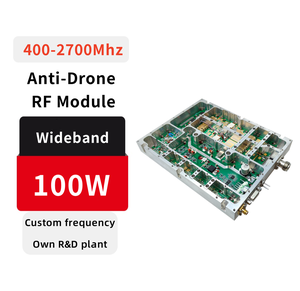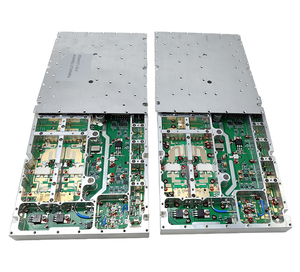Types of RF amplifier circuits
An RF amplifier circuit is a circuit used to amplify signals in the radiofrequency range. RF amplifiers are used in various applications like radio, television, mobile phones, and other communication systems. There are different types of RF amplifier circuits, and each type has its advantages and disadvantages.
- Common emitter RF amplifier: In this RF amplifier, the input is applied to the base, output is taken from the collector, and the emitter is common. It can provide high voltage gain and has good input and output impedance.
- Common base RF amplifier: In this RF amplifier, the base is common between the input and output. The input is applied to the emitter, and the output is taken from the collector. It has good high-frequency response and low input impedance.
- Darlington pair: This type of RF amplifier consists of two transistors. The first transistor is connected in common emitter configuration, and the output of the first transistor is connected to the base of the second transistor. This type of amplifier provides high current gain and is used in applications where high input impedance is required.
- Cascode amplifier: The cascode RF amplifier consists of a common emitter transistor and a common base transistor. The common base transistor is connected to the common emitter transistor in series. This type of amplifier provides high gain, good bandwidth, and low noise.
- Differential amplifier: The differential RF amplifier is used to amplify the difference between two input voltages. It has good common-mode rejection and is used in applications where the input is in the form of a differential signal.
- Push-pull amplifier: The push-pull RF amplifier uses a pair of transistors that work in push-pull configuration. It can provide high power gain and is used in applications where high power output is required.
- Class A RF amplifier: The class A amplifier conducts current throughout the entire cycle of the input signal. It provides high linearity but is less efficient.
- Class B RF amplifier: The class B amplifier conducts current for only half of the input signal cycle. It is more efficient but has lower linearity.
- Class C RF amplifier: The class C amplifier conducts current for less than half of the input signal cycle. It is highly efficient but has poor linearity.
Functions and Features
A radio frequency (RF) amplifier has many functions and features that can vary depending on the intended use of the amplifier. Some of these functions and features are;
- Bandwidth: The bandwidth of an amplifier is the range of frequencies through which it can operate. A good RF amplifier should have a wide bandwidth to allow it to handle many signals at a go. The bandwidth of an amplifier is determined by the input and output impedances and the frequency response of the amplifier. Bandwidth is a very important feature in an amplifier, as it determines the range of signals an amplifier can handle.
- Input and output impedances: The input impedance of an amplifier is the resistance that the output of a device presents to the input of the amplifier. It is usually measured in ohms. Also, the output impedance is the resistance that the input of an amplifier presents to the output of the device. The input and output impedances of an amplifier are very important, especially in a transceiver. This is because the impedance has to match the impedance of the antenna for the transmitter to work properly.
- Gain: The gain of an amplifier is usually expressed in decibels (dB) and is the ratio of output power to input power. The gain of an amplifier is usually positive and is used to amplify the input signal so that it can be transmitted over a long distance without losing its strength. An amplifier may also have a negative gain, which is used to reduce the strength of the signal.
- Linearity: Linearity is the ability of an amplifier to accurately reproduce the input signal without introducing any distortion. Linearity is a very important feature of an amplifier, especially in communication systems, where the message being transmitted needs to be clear and free of errors.
- Efficiency: Efficiency is the ratio of output power to input power. A good RF amplifier should be efficient in terms of power consumption.
- Isolation: Isolation is the ability of an amplifier to isolate the input and output signals. Isolation is measured in decibels and is the ratio of the input signal to the output signal. An amplifier with good isolation will be able to reduce the amount of feedback and crosstalk between different channels in a communication system.
Applications of rf amplifier circuit
The RF amplifier circuit has many uses, including the following:
- Amateur radio: This is a popular hobby for radio enthusiasts. The RF amplifier circuit allows the user to transmit signals over long distances.
- Television and radio broadcasting: RF amplifiers are used to boost the signal strength of TV and radio stations so that they can be received by viewers and listeners over a large area.
- Wireless communications: RF amplifiers are used in wireless communication systems, such as cell phones, to amplify the signal before it is transmitted through the air and received by the intended recipient.
- Radar systems: RF amplifiers are used in radar systems to transmit high-power radio frequency pulses and detect objects in the environment. Military and commercial aircraft, ships, and weather monitoring stations use radar systems.
- Medical equipment: RF amplifiers are used in medical devices such as MRI machines and radiation therapy equipment to create and amplify the radio frequency signals needed for diagnosis and treatment.
- Security systems: RF amplifiers are used in security systems, such as motion detectors and surveillance cameras, to amplify the signals that are used to monitor and protect homes and businesses.
- Astronomy: RF amplifiers are used in radio astronomy to amplify weak radio signals from space that are emitted by celestial bodies such as stars, galaxies, and black holes.
- Industrial applications: RF amplifiers are used in industrial applications, such as plasma etching, semiconductor manufacturing, and materials processing, to create and amplify radio frequency signals for various processes and procedures.
- Test and measurement equipment: RF amplifiers are used in test and measurement equipment, such as spectrum analyzers and network analyzers, to amplify signals for testing and analyzing radio frequency devices and systems.
How to choose RF amplifier circuits
When choosing an RF amplifier circuit for a specific application, it is important to consider the power requirements, frequency range, gain, noise figure, linearity, efficiency, and environmental conditions.
Power requirements are essential in determining the suitable amplifier circuit for an application. It is important to consider the minimum and maximum power levels that the circuit can handle without distortion or damage. The power handling capability of an amplifier is usually specified as the maximum input or output power before distortion occurs. This parameter is critical for applications that require high power levels, such as broadcasting, and should be carefully evaluated to avoid damage to the amplifier circuit.
Frequency range is another important factor to consider when choosing an RF amplifier circuit. It is essential to select a circuit that can operate within the desired frequency band. Some amplifier circuits are designed for specific frequency ranges, while others offer broader bandwidths. Therefore, it is important to carefully evaluate the frequency range specifications of the circuit to ensure compatibility with the application.
The gain of an RF amplifier circuit is a measure of its signal amplification capability. It is important to select a circuit with sufficient gain to meet the application's requirements. The gain specification of the circuit should be carefully evaluated to ensure it meets the desired signal amplification needs.
Noise figure is another important parameter to consider when choosing an RF amplifier circuit. It is a measure of the circuit's noise performance and indicates how much additional noise the amplifier will introduce into the signal. Low noise figure is desirable for applications that require sensitive signal reception.
Linearity is the ability of the amplifier to reproduce the input signal accurately without distortion. It is an essential factor to consider, especially for applications that require the faithful reproduction of the input signal.
The efficiency of an amplifier circuit is an important parameter to consider, especially for battery-powered applications. It is important to select a circuit with good efficiency to minimize power consumption and extend battery life. The efficiency of the circuit is usually specified as the output power divided by the input power.
It is also important to consider the environmental conditions in which the RF amplifier circuit will operate. Some amplifier circuits are designed to withstand harsh environmental conditions, such as high temperatures or humidity levels. Therefore, it is important to carefully evaluate the environmental specifications of the circuit to ensure it can perform optimally in the intended environment.
Rf amplifier circuit Q and A
Q1: What are the common RF amplifier types?
A1: The common RF amplifier types include the broadband amplifier, low-noise amplifier, power amplifier, and high-frequency amplifier.
Q2: What are the applications of an RF amplifier?
A2: RF amplifiers are used in various applications, including two-way radios, RF test equipment, RF heating, MRI systems, and radar systems.
Q3: What is the purpose of impedance matching in an RF amplifier circuit?
A3: Impedance matching is done to transfer maximum power from the amplifier to the load. It prevents reflections and ensures efficient signal transfer.
Q4: What are the key components of an RF amplifier circuit?
A4: The key components of an RF amplifier circuit are the active device (transistor), passive components (resistor, inductor, and capacitor), and matching networks.
Q5: What are the safety precautions when working with RF amplifiers?
A5: When working with RF amplifiers, it is important to follow safety precautions like using proper grounding, handling high voltages with care, and ensuring proper ventilation for heat dissipation.








































